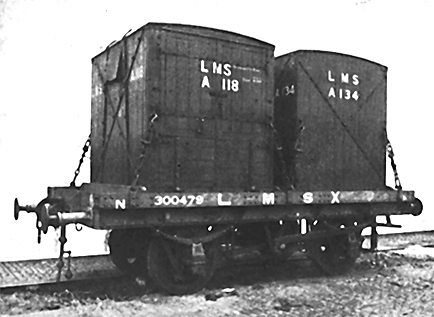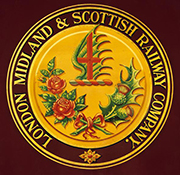

This site uses non-intrusive cookies to enable us to provide a better user experience for our visitors. No personal information is collected or stored from these cookies. The Society's policy is fully explained here. By continuing to use this site you are agreeing to the use of cookies.
[as described in the October 1928 edition of the “in-house” LMS Magazine.]

Type "D" Open Container
CONTAINERS represent the latest development in the conveyance of goods traffic over British railways. Comparatively few people, however, appreciate the real distinction which exists between them and various forms of privately-owned lift-vans or boxes used for rail transport of goods, and it is hoped that this short article may be of interest to all, and useful to those whose daily task brings them in contact with the subject.
On recurring occasions during the past, the use of containers has been considered by railway managements, but up to two years ago, the objective was always the same - to economise in the manual labour expended in handling small package goods traffic, such as boxes of soap, nails in bags, &c. containers have, in fact, been so used for many years, notably for parcels traffic between London and Ireland : a special truck carrying six containers usually forming part of the London-Holyhead and Loudon-Heysham boat trains. The long-standing use of flats for the Lancashire cloth traffic may also be said to be a type of container operation insofar as the flat enables a multiplicity of pieces of cloth to be handled as a complete unit.
The Container system, as it has been established, however, has not been based on the economics of goods-station operation, but as a commercial facility of great value to traders, while at, the same lime enabling the railway companies to meet certain forms of road competition at least on equal terms.
When the latest phase of investigation into the subject was initiated by the LMS some two years ago, it soon became apparent that the old idea of the container as a "box" must be abandoned, and that the principle governing its use must be founded on the theory that it is the mobile part of a truck. The vital importance of this theory will be gathered from the explanation given in this article of the principles of charging for traffic conveyed in containers.
Four standard types of container have been evolved, corresponding to the body portions of the covered railway van and open wagon respectively, in full truck size and half-truck size.
In arriving at the various types, regard has been paid to the normal capacity of cranage and cartage equipment, but, subject to these limitations, the aim has been to obtain a container of maximum size with minimum tare. The present L M S stock, which numbers about 800, is constructed of wood, but experiments are being made with steel and other materials with the object of reducing maintenance costs and securing greater durability without increase of tare. Containers are at the present time being conveyed in ordinary open wagons having low sides, but, nevertheless, they require nothing more than a chassis such as the steel underframe or running part of a truck. It is interesting to note that a complete container-truck fitted with the large covered-type container can be built at less cost than an ordinary covered van.
There is nothing really extraordinary in the idea of having the body of your railway truck detachable from its wheels, but the adoption of this simple expedient produces far-reaching effects of a beneficial character, provided the system is kept in its proper sphere by suitable measures, failing which containers could be a real menace to the railway company's revenue.

Type "A" Covered Container On Wagon
The most important problem which confronted the investigators in the early stages was how to keep a clear legal line of demarcation between railway companies' containers and the various forms of packing receptacles used by traders, and so be in a position to charge for the net weight of goods in railway containers without undermining the statutory principle of gross weight charging for goods train traffic. Its solution has been to regard traffic carried in containers as "not packed" and charge rates at appropriate percentage, according to commodity above the rates for the same traffic carried in ordinary wagons. This is an adaptation of longstanding provisions exemplified in some entries in the Railway Classification, where the class of merchandise not packed as prescribed is raised by one or more classes, for example: Toys, packed, class 17; not packed, class 18.
The operation of this system of differential charging will be grasped from the following hypothetical example of the charges on a consignment of confectionery passing by container, and ordinary truck respectively between the same points :-
Five tons confectionery, gross weight (includes 10 cwt., weight of packing cases): Ordinary rail rate, £2 per ton.
Charges by ordinary truck would be :-
| £ | s | d | |
| 5 tons at £2 per ton | 10 | 0 | 0 |
| 10 cwt., return empties (say) | 1 | 0 | 0 |
| 11 | 0 | 0 |
NOTE.-The net weight of confectionery was only 4½ tons, so that the cost per net ton was about 49s.
In containers the same consignment would cost :-
| £ | s | d | |
| 4½ tons at 44s., i.e., £2 plus 10 per cent. | 9 | 18 | 0 |
It will be seen that broadly the effect is to relieve the trader of his packing cost, including railway freight on the return empty cases.
The view might reasonably be formed from such figures that the railway company would be the losers by a general application of this principle, but it must be borne in mind that "Return empties" of themselves are an unprofitable traffic, and also that traders will not to-day incur the heavy expense of packing their bulk consignments of traffic to ensure safe rail conveyance, when they can get the same traffic carried by road with almost an absence of exterior packing.
With a few limited exceptions, containers are only supplied for consignments of one ton and upwards, from one sender to one consignee. The imposition of a minimum weight condition was essential to safeguard the companies against being compelled to supply containers for relatively small consignments. This question of "minimum load" ranks almost equal in importance with principle of differential charging, because both serve to keep the obligation of the companies as to the supply of containers within definite bounds, without impairing their combative efficiency against road competition.
It has already been made clear that the use of containers is confined to bulk consignments. This class of business when loaded into proper receptacles forms a compact mass, and, so to speak, packs itself, and hundreds of loads of highly damageable commodities such as furniture, gas stoves, sanitary ware, &c., arc being so carried with an infinitesimal amount of damage.
The conditions at the classification as to risk tor unpacked goods are at present being applied to container conveyance, but as experience shows that risk with any given traffic loaded in containers is negligible, consideration is being given to relaxing them.
For the time being, containers are not being employed to carry rough traffics such as bricks, roadstone, &c., and although the need for the bulk handling of such commodities is apparent to the merest layman, it would be impracticable with existing cranage equipment at many stations to deal with the large flow of containers which their use for mineral traffic would create. Further research is proceeding along this and other definite lines such as the provision of insulated container stock for meat.
Railway companies in other lands, notably America, are developing the container system of freight transportation, and, like the British lines, are finding them of great value in providing traders with that necessary ingredient of successful trade-efficient, safe, and economical door-to-door transport.

Type "B" Large Covered Container
Site contents Copyright © LMS Society, 2026

January 5th, 2026
Site contents Copyright © LMS Society, 2026